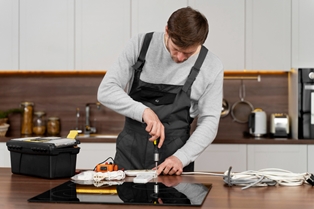In modern homes, appliances are essential for daily comfort and convenience. However, like all machines, they are prone to issues that can disrupt our routines. Understanding common appliance problems and knowing how to fix them can save time, money, and the hassle of unnecessary service calls. Below, we provide an in-depth guide to troubleshooting and repairing some of the most frequently encountered appliance issues.
1. Refrigerator Not Cooling Properly
A refrigerator that isn’t cooling effectively can lead to food spoilage, wasting both money and resources.
Common causes include:
Dirty Condenser Coils:
Dust and debris can accumulate on the condenser coils, reducing the refrigerator’s cooling efficiency.
-
Solution: Unplug the refrigerator, locate the coils (usually at the back or underneath the unit), and clean them using a vacuum or a coil brush.
Faulty Evaporator Fan:
The fan is responsible for circulating cool air throughout the refrigerator. If it malfunctions, you may notice a warmer interior.
-
Solution: Check if the fan is spinning when the fridge is running. If not, the fan motor may need to be replaced.
Temperature Control Malfunction:
If the thermostat fails, it may not send the correct signal to the cooling system.
-
Solution: Test the thermostat with a multimeter. If it’s defective, replace it with a new one.
2. Washing Machine Not Draining
A washing machine that won’t drain can leave you with a tub full of water and wet clothes.
Common culprits include:
Clogged Drain Hose:
Debris can block the drain hose, preventing water from exiting the machine.
-
Solution: Detach the hose and inspect it for clogs. Clear any obstructions before reattaching it.
Faulty Pump:
The drain pump may fail or become obstructed by foreign objects.
-
Solution: Access the pump by removing the machine’s front panel. Check for blockages or test the pump’s motor with a multimeter and replace it if necessary.
Lid Switch Issue:
In top-loading machines, the lid switch is a safety feature that stops the machine from spinning when the lid is open. If it’s faulty, the machine may not drain.
-
Solution: Test the switch for continuity and replace it if needed.
3. Dishwasher Not Cleaning Dishes Properly
A dishwasher that doesn’t clean well can be frustrating, especially when dishes come out as dirty as they went in.
Common reasons include:
Spray Arm Blockages:
Food particles or hard water deposits can block the spray arms, preventing them from spinning properly.
-
Solution: Remove the spray arms and clean out any debris. Soaking them in vinegar can help dissolve mineral deposits.
Clogged Filter:
A clogged filter can prevent water from circulating properly within the dishwasher.
-
Solution: Locate the filter (usually at the bottom of the dishwasher) and clean it regularly to ensure optimal performance.
Detergent Issues:
Using the wrong type or insufficient amount of detergent can affect cleaning performance.
-
Solution: Use a high-quality detergent recommended by the manufacturer and ensure you’re using the correct amount.
4. Dryer Not Heating
When a dryer isn’t producing heat, clothes can take hours to dry or remain damp, leading to frustration and increased energy costs.
Common issues include:
Blown Thermal Fuse:
The thermal fuse is a safety device that shuts off the heating element if the dryer overheats.
-
Solution: Test the fuse with a multimeter and replace it if blown.
Faulty Heating Element:
If the heating element is damaged, the dryer won’t generate heat.
-
Solution: Inspect the element for breaks or damage and replace it if necessary.
Clogged Vent:
A clogged vent can restrict airflow, causing the dryer to overheat and potentially trip the thermal fuse.
-
Solution: Clean the dryer vent regularly to maintain proper airflow and prevent overheating.
5. Oven Not Heating Evenly
An oven that doesn’t heat evenly can lead to undercooked or overcooked food, making meal preparation a challenge.
Potential causes include:
Malfunctioning Bake or Broil Element:
If the heating elements are not functioning correctly, the oven may not heat evenly.
-
Solution: Test the elements with a multimeter and replace them if they are faulty.
Temperature Sensor Issues:
The oven’s temperature sensor monitors the heat and signals the heating elements to turn on or off.
-
Solution: If the sensor is malfunctioning, it may need to be replaced to ensure accurate temperature control.
Calibration Problems:
Over time, the oven’s thermostat may become miscalibrated, leading to temperature inconsistencies.
-
Solution: Consult your oven’s manual to learn how to recalibrate the thermostat for accurate temperature settings.
6. Microwave Not Heating
A microwave that isn’t heating food is essentially useless, but several common issues can be addressed:
Faulty Magnetron:
The magnetron is the component responsible for generating the microwaves that heat food.
-
Solution: If the magnetron is defective, it will need to be replaced by a professional, as it involves handling high-voltage components.
Door Switch Problems:
The microwave won’t operate if the door switch isn’t engaged properly.
-
Solution: Inspect the door switch mechanism and replace it if it’s not functioning correctly.
Blown Fuse:
A blown internal fuse can prevent the microwave from working.
-
Solution: If you’re comfortable working with electronics, replace the fuse with one that matches the specifications of your microwave.
Conclusion
By understanding and addressing these common appliance problems, you can extend the lifespan of your household devices and avoid unnecessary repair costs. Regular maintenance, prompt repairs, and following manufacturer guidelines are key to ensuring your appliances continue to operate efficiently.





Find Us on Socials